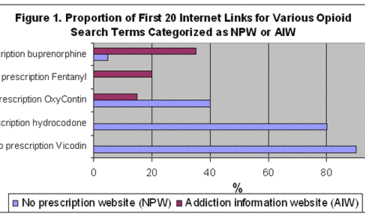The National Drug Use and Health Study (Substance Abuse and Mental Health Services Administration 2004), the Drug Abuse Warning Network (Substance Abuse and Mental Health Services Administration 2005), and the Monitoring the Future Study (Johnston, O’Malley, and Bachman 2005) note an increase in opioid use (e.g., Codeine, Vicotin, OxyContin) among young people during the last five years. The reason for this increase in opioid use is unknown. In the last issue of ASHES 3(3), we reviewed a study showing that minors are able to purchase cigarettes over the Internet. It is important to examine whether the increased use of other illicit substances might be due to increased accessibility via the internet (Working Group on Unlawful Conduct on the Internet 1999) To pursue this point, this week’s STASH examines the prevalence of websites selling opioids on the Internet without a prescription.
Forman, Woody, McLellan, and Lynch (2006) conducted Google searches during August 2004 using 27 opioid search terms (i.e., generic and brand name opioids) with and without the prefix “no prescription.” Two coders independently examined the first 20 links (i.e., the links most likely to be influential to Internet users) generated through these searches and categorized each link as: 1) no prescription website (NPW) if it sold opioids directly or through a portal website without a prescription; 2) addiction information websites (AIW) if it contained information about opioids, drug use or drug treatment (e.g., www.nida.nih.gov); or, 3) other if it was a legitimate link to an online pharmacy, a broken link or a different type of link (e.g., name of the rock group Codeine). Discrepancies in classification between the coders were reconciled by having both raters look at the link together and discuss the classification (i.e., inter-rater reliability was not calculated).
Figure. Adapted from (Forman et al. 2006). Click image to enlarge.
As shown in Figure 1, the proportion of NPWs or AIWs varies across the opioid search terms. Some search terms such as no prescription hydrocodone, no prescription Vicodin, and no prescription OxyContin yielded more NPWs than AIWs. Alternatively, some search terms such as no prescription buprenorphine and no prescription Fentanyl yielded more AIWs than NPWs.
This study has some limitations. This is an exploratory study: it is not based on a priori hypotheses. Therefore, the information provided is simply descriptive. It is important to keep in mind that researchers made no attempt to buy opioids from these websites, so we do not know if it really is possible to purchase opioids from these sites without a prescription.
Despite these limitations, this is the first published study that conducts an examination of the prevalence of websites reporting that they sell opioids without a prescription. Findings from this study suggest that Internet users can obtain opioids illegally via the Internet and that NPWs often are more prevalent than websites providing educational information about these drugs. These findings are particularly worrisome because young people might have an easier time purchasing opioids over the Internet (e.g., using their parents’ credit card) than they would purchasing such drugs in person at legal venues (e.g., a pharmacy). To address this growing public health concern, there is a need to strengthen existing legal and medical regulations to prevent illegal selling of opioids via the Internet and improve dissemination of literature to educate the public about the dangers of using opioids without medical supervision.
What do you think? Please use the comment link below to provide feedback on this article.
References
Forman, Robert F., George E. Woody, Thomas McLellan, and Kevin G. Lynch. 2006. The Availability of Web Sites Offering to Sell Opioid Medications Without Prescriptions. American Journal of Psychiatry 163 (7):1233-1238.
Johnston, Lloyd D., Patrick M. O’Malley, and Jerald G. Bachman. 2005. Monitoring the Future: National Results on Adolescent Drug Use. Bethesda, MD: U.S. Department of Health and Human Services, Public Health Service, National Institutes of Health.
Substance Abuse and Mental Health Services Administration. National Survey on Drug Use and Health 2004 [cited February 14, 2006. Available from http://oas.samhsa.gov/nsduh.htm#NSDUHinfo.
Substance Abuse and Mental Health Services Administration. Drug Abuse Warning Network 2005 [cited. Available from https://dawninfo.samhsa.gov/default.asp.
Working Group on Unlawful Conduct on the Internet. The White House Executive Order 13133 1999 [cited. Available from http://nodis3.gsfc.nasa.gov/displayEO.cfm?id=EO_13133_.





